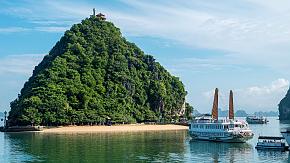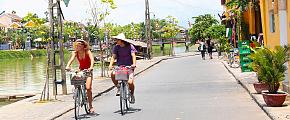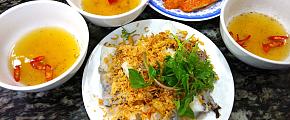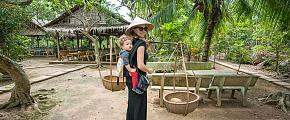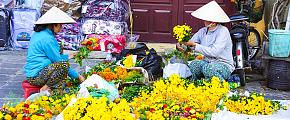Hanoi Travel Guide
Vietnam's capital, Hanoi, is among the world's oldest cities. Emperor Ly Thai To gave Hanoi the name Thang Long when it was established next to the Red River in 1010. The city's center, a diversified metropolis that blends history and modernity, provides a blend of modern and classical architecture, as well as an abundance of gastronomy, intriguing sites, and friendly locals. Even a brief visit may have a significant impact because to the region's distinctive architecture, interesting history, and delectable street cuisine. Visit the Old Quarter and go on a picture tour to learn about the unique way of life of the Vietnamese. It's also a good idea to unwind in the city's and suburbs' natural surroundings.
Here's a guide to help you explore Hanoi and make sure you have a better experience in the city.
Top Attractions
1. Hanoi Old Quarter
The Old Quarter in Hoan Kiem District, a labyrinthine area also known as 36 Old Street, is the main draw for tourists to Hanoi. Fine French architecture, traditional Vietnamese tube houses, picturesque lakes, historical museums, delectable street food, beautifully lined cafes, bakeries, and bars - all of these may be found here. The region to explore is the Old Quarter, which has a variety of hotels and winding streets lined with people and cars. Walking among the buildings and taking in the spirit of life in the old town is the finest way to experience it. If you like, you may spend the entire day doing this. When the old town is packed and crowded in the morning, you will observe people enjoying breakfast at street booths. In the evening, the old town is bustling with diners and beer drinkers, and the mood is casual and laid-back.
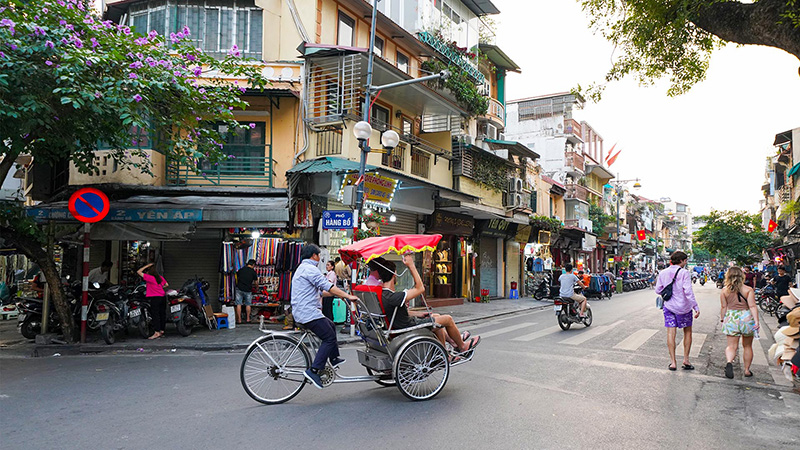 Hanoi Old Quarter
Hanoi Old Quarter
2. Street Food Tour
One way to make your trip unforgettable is to take a street food tour with friends and family. The Old Quarter is home to some of Vietnam's gastronomic mainstays. You can experience several sorts of street food by navigating the winding streets and obscure alleys. A precise combination of salty, sweet, sour, and spicy flavors forms the foundation of Vietnamese cuisine in general, and rich seasonings and side dishes are used to give the food a distinctive flavor. You can generally eat the food you want wherever you dine. Top Vietnamese foods include pho, Bun Cha, and Bun Thang. Caramel brulee or fried bananas are also wonderful options if you have a sweet tooth. In addition to providing a unique culinary experience, street food is a fantastic way to discover the Old Quarter.
3. Hanoi Train Street
Numerous people stop to take pictures and explore the intriguing location of the Train Street that runs through the center of Hanoi's Old Quarter. Sitting in a street-side cafe with a spectacular view of the approaching trains and a sight of the people going about their everyday lives is especially enjoyable for first-time visitors. The fact that there are homes on both sides of the rails, perfectly spaced out, is what makes Train Street unique. All residents and guests must take precautions to keep themselves, their pets, and their things safe when a train is coming. A different picture awaits you on the other side of Hanoi's Train Street, where lovely cafes and tables are set up for guests to take pleasure in a typical cup of coffee. You don't have to worry about food at all because there are other establishments that sell fruit and baked items. In addition, you must taste the egg coffee at Café Giang on Train Street.
 Hanoi Train Street
Hanoi Train Street
4. Dong Xuan Market
The biggest market in Hanoi is Dong Xuan Market, which is situated on the northern edge of the Old Quarter. Here you can experience the authentic local life. The market, which has four levels, is a regal structure designed in a Soviet style and is renowned for its high-quality products and competitive rates. Each floor of the market offers a large selection of goods, and the surrounding shops sell vegetables, flowers, apparel accessories, and gift-wrapping materials. If you're seeking for Vietnamese food, you can also get it in the market.
5. Hoan Kiem Lake
Hoan Kiem Lake, a well-known tourist destination in Hanoi and one of the most recognizable lakes in all of Vietnam, is close to the Old Quarter. This lush body of water is not only a sight to behold, but it also makes for the perfect gathering spot throughout the day, especially in the morning and evening. One of the most popular tourist photo locations is the three-story turtle tower in the middle of the lake, which is in addition to the lake's natural scenery. You can observe folks strolling and running along the lake's edge, sipping coffee in one of the cafes nearby, taking in a street performance, and just relaxing. The best days to visit Hoan Kiem Lake are on Friday through Sunday, when traffic is limited and it is more enjoyable for tourists to stroll around.
6. Ngoc Son Temple
Ngoc Son Temple is one of Hanoi's well-known temples. It is situated to the north of Hoan Kiem Lake and is connected to the land by the Huc Bridge, a red-arched bridge. General Tran Hung Dao, who defeated the Mongols in the 13th century, scholar Van Xuong, and the patron saint of physicians, La To, are three national heroes honored at Ngoc Son Temple, which was built in the 18th century. It is a destination where you may learn about Vietnamese religious history and culture and gives stunning views of the lake and the area around Ngoc Son Temple.
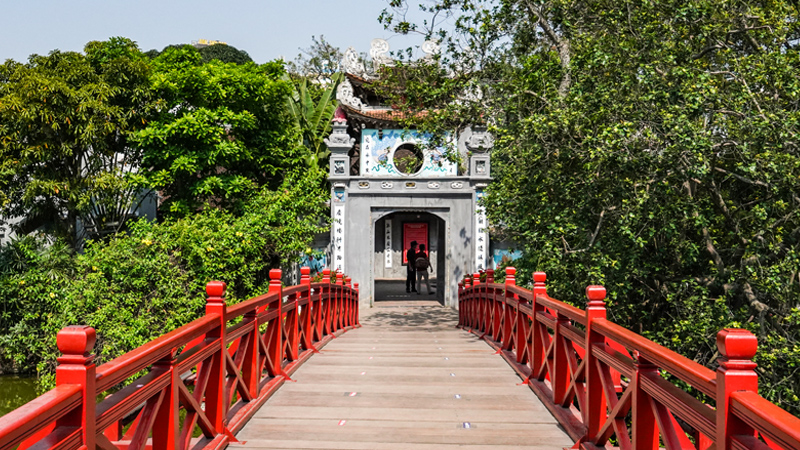 Ngoc Son Temple
Ngoc Son Temple
7. Ho Chi Minh Mausoleum
The Ho Chi Minh Mausoleum, a huge complex of Ho Chi Minh's graves and monuments, is the former residence of Ho Chi Minh, Vietnam's greatest political leader, and a popular destination for Vietnamese pilgrims. It is situated in Dien Bien Street, Ba Dinh District. Ho Chi Minh, who headed the Viet Minh independence campaign in 1941 and went on to become the country's first president in 1945, is credited with creating the modern communist state of Vietnam. He tragically passed away during the Vietnam War in 1969 from heart failure. In the mausoleum, which is a modest dark-gray marble building, visitors can see Ho Chi Minh's body preserved in a crystal coffin as well as other of his personal possessions and details about the history of the Vietnamese revolution. The Ho Chi Minh Mausoleum is a fantastic destination for first-time tourists to learn more about Vietnam's history.
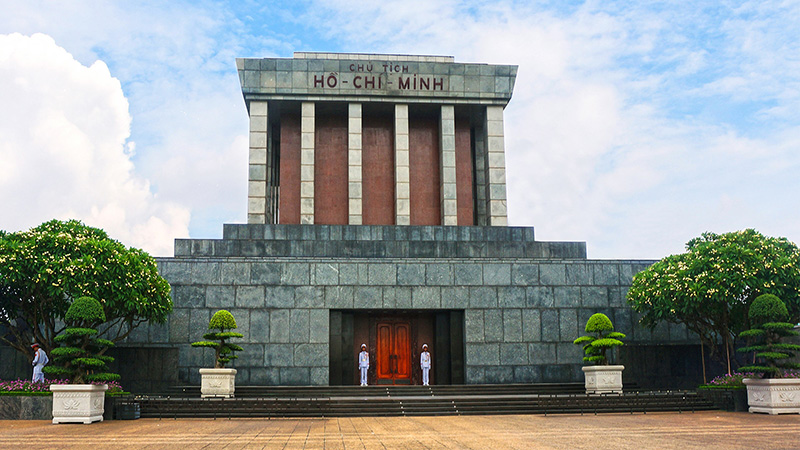 Ho Chi Minh Mausoleum
Ho Chi Minh Mausoleum
8. St. Joseph's Cathedral
St. Joseph's Cathedral, Hanoi's oldest cathedral, is located in the Old Quarter. One of Hanoi's most famous religious structures, it was the first structure constructed by French colonists in Indochina and was finished in 1886. The church's exterior is constructed in Western form and is created in a Gothic Revival style that was influenced by Notre Dame Cathedral in Paris. However, the interior features stained glass and elaborate flower arrangements in hues inspired by Vietnam. The heart of Catholicism in North Vietnam, the French colonial St. Joseph's Cathedral, was shut down in 1954 when the colonists left and reopened in 1990 following the creation of the Vietnamese government. A visit to the cathedral offers an opportunity to learn about Vietnamese history in addition to seeing the building's stunning facade.
9. Temple of Literature
One of Hanoi's most intriguing sights, the Temple of Literature, is a remarkable example of traditional Vietnamese architecture and dates back to the 11th century. Originally devoted to Confucius, the temple was briefly utilized as a military location during the French occupation. Today, the Temple of Literature serves as a monument to the nation's intellectuals and is the location of a poetry festival in Hanoi. A stone tablet known as the Stele of Doctor, etched with the names of former students, is one of the Temple of Literature's great attractions. In addition to being a well-known historical landmark in Hanoi, the Temple of Literature is also a place where traditional Vietnamese values are upheld.
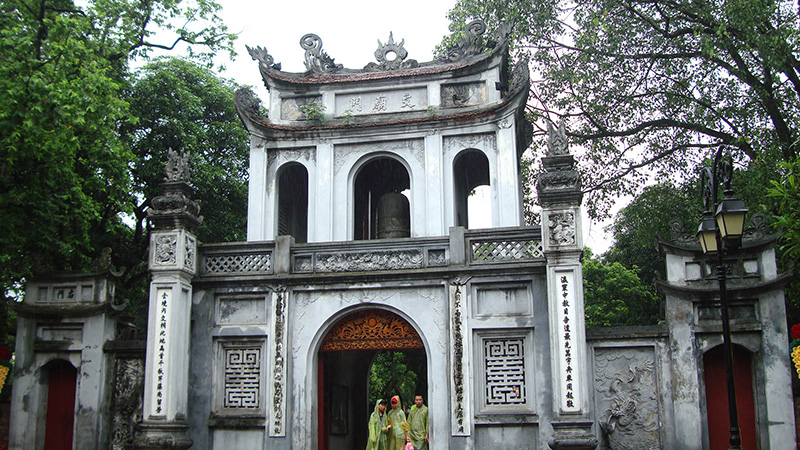 Temple of Literature
Temple of Literature
10. Hanoi Opera House
The Hanoi Opera House, the largest theater in Vietnam and one of Hanoi's most beautiful structures, was constructed by the French in 1911. The theater has a gothic theme that effectively captures French neo-classical architecture. The opera building is made spectacular and exquisite by its tall columns, shutters, and dome. When Vietnam first encountered Western art, Hanoi Opera House served as a cultural hub for the French and Vietnamese aristocracy. As time went on, more significant political events were held there. Hanoi Opera House now serves primarily as a stage for artistic acts, showcasing anything from opera and classical music to traditional Vietnamese theater. Since French colonization, the Hanoi Opera House has seen how Vietnamese traditions have changed.
11. Imperial Citadel of Thang Long
The Imperial Citadel of Thang Long, one of Hanoi's oldest structures and a UNESCO World Heritage Site, stands out for its extensive cultural significance and lengthy history. The Imperial Citadel, which served as Hanoi's historic political and military epicenter, was crucial to the Vietnam War's overall strategy. Additionally, you can discover bunkers from the Vietnam War and look through the buried military charts and gear. The remnants of the citadel, despite the fact that French colonialists mostly destroyed it, still add greatly to our understanding of Vietnam's past.
12. Thang Long Water Puppet Theatre
The Thang Long Water Puppet Theater, beside Hoan Kiem Lake, is one of the must-see sights to visit while in Hanoi. Here, you may watch a conventional water puppet show. Vietnamese folklore and festivities of the rice harvest are told through puppetry. The puppets are supported by a big stick and managed by an experienced puppeteer to make the show more entertaining and natural. With the help of real traditional Vietnamese instruments, puppeteers present colorful folk tales while submerged up to their waists in water. The finest method to experience traditional Vietnamese art and entertainment is through water puppetry, which is a pleasant family activity for the evening.
When Is The Best Time To Visit Hanoi
In general, February to April and September to November are the ideal months to visit Hanoi. This is a wonderful time to decide whether you want to visit Hanoi to take in the stunning natural landscape, taste the local food, or attend the shows or festivals.
A nice time to travel and see Hanoi on foot is from February to April and from September to November, which are Spring and Autumn in Hanoi, respectively, and also peak months for tourism in Hanoi. During these seasons, the weather is pleasant, clear, and occasionally rainy. Additionally, the most significant Tet Nguyen Dan (Spring Festival) and Tet Trung Thu (Mid-Autumn Festival) in Hanoi fall around this season, allowing you to partake in wonderful food and revel in the celebratory ambiance.
Winter in Hanoi is in December and January, with an average temperature of 17 degrees Celsius. It is also a popular time for international tourists to spend their holidays. If you don't mind the cold and dry weather, it is also a good time to visit Hanoi.
Summer is from May to September, when the weather is hot, humid and rainy. It is also considered to be the off-season for tourism in Hanoi. If you don't mind the hot weather, you can choose to visit Hanoi in summer and enjoy the corresponding discounts and avoide the tourist crowds.
How to Travel Around Hanoi
The best method to navigate about Hanoi is by foot, although you can't walk all the way around the city center because it is a very large city. There are a few options you may try if you'd want a simpler method to navigate Hanoi.
Grab / Uber: It's cheap and convenient, much cheaper than the cost of a traditional taxi. But be aware that Grab is in high demand during cold or rainy weather.
Bus: Public buses in Hanoi are mostly white, red, and yellow, and they may carry you everywhere in the city for a fee that depends on the bus type and distance. Hanoi also has an electric bus system that includes English commentary. An excellent option for those with restricted mobility is the bus.
Cyclo: Cyclo is a very common form of transportation in Hanoi and have been around for many years and are now used for tourism. Taking a cyclo to Hanoi's famous sights is also a novel experience, and one you must try if you are visiting Hanoi for the first time.
Taxi / Motorbike taxi: As it is simple to rent a motorcycle anyplace in Vietnam, Hanoi also has a large number of taxis and motorbike taxis. However, while hiring a motorcycle, consider parking, watch out for fines, and also look for a trustworthy taxi service.
Private Car: If you travel with Odynovo, we can make more professional travel routes for you, making your trip more convenient and efficient.
Known as the historical and cultural center of Vietnam, Hanoi is not only full of mystery and unknown, but also full of vitality and creativity. Hanoi is well worth a visit as there are many things to do, from sacred temples to scenic lakes to bustling night markets. Just contact us, and we will customize a hassle-free trip for you to discover the surprises and delights in this capital city of Vietnam.

